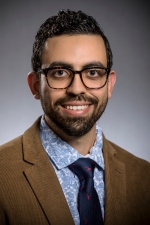
It’s more critical during this pandemic than ever.
May is Stroke Awareness Month
By John Hanna, MD, medical director at Atlantic Health System’s comprehensive
stroke center, Overlook Medical Center
While COVID-19 has halted many things, it hasn’t put a stop to the number of patients suffering a stroke. In fact, since the start of the pandemic, there has been a rise in the number of strokes — including an increase in the number of young and middle-aged people suffering them.
Yet, fewer stroke victims are seeking immediate care, which is key to giving them the best chance at recovery. They are afraid of contracting the virus in a medical facility and erroneously believe the risk of coronavirus infection is a greater threat than stroke.
As a vascular neurologist, I assure you it is not.
Stroke is the fifth leading cause of death in the U.S. Having a stroke is a major emergency that requires immediate medical intervention, and anyone who experiences symptoms of stroke must not test time. Every minute that passes without treatment costs the brain millions of neurons and can cause lifelong disabilities. Quick intervention saves lives and can minimize — and in some cases reverse — serious damage to the brain and nervous system.
Atlantic Health System’s five state-designated stroke centers continue to take extraordinary precautions to minimize the risk of coronavirus exposure and provide swift treatment for each patient’s best outcome. Our revamped emergency department protocol enables patients arriving with suspected stroke to have most, if not all, of their diagnostic evaluation and emergency treatment handled in one location.
Here’s a scenario:
Someone experiences one or more of the tell-tale signs of stroke, expressed in the acronym, BE FAST:
B stands for trouble with balance;
E for eyes and vision problems;
F for facial droopiness;
A for arm (or leg) weakness;
S for speech problems; and
T is for time. A call to 911 is immediately placed.
Getting to the hospital by ambulance is best because first responders know the location of the closest Joint Commission and New Jersey-designated stroke centers and will relay vital signs and other key patient information to the medical staff ahead of arrival.
The patient is greeted by emergency department (ED) staff in full protective gear (N-95 masks, gloves and gown), given a mask and tested for COVID-19. The patient is brought directly to a room for a CT-scan. A vascular neurologist not in the ED uses a telestroke robot to review the CT-scan results, ask questions of the patient, and conduct a remote examination with assistance from an ED nurse. The neurologist also uses the telestroke robot to talk to the patient’s family member.
The neurologist determines if a stroke occurred and, if so, whether it was ischemic or hemorrhagic. An ischemic stroke is caused by a blood clot that is blocking blood supply to the brain. A hemorrhagic stroke is caused by a ruptured blood vessel that causes bleeding in the brain.
A patient who would benefit from tPA, the clot-busting medication that can reverse damage caused by ischemic stroke, receives it right away in the same room. Others may have a clot surgically removed. A patient who experienced a hemorrhagic stroke is given medications to reduce blood pressure and slow bleeding.
The patient is moved to a hospital room only after he or she is stabilized, and the treatment space is then sanitized. We call this process “bundling care.” It further reduces the patient’s and staff’s potential exposure to the coronavirus.
During the pandemic, I’ve treated people who had no risk factors for stroke yet suffered major strokes — including young and middle-aged patients. At the hospital, they tested positive for COVID-19, despite having been asymptomatic to that point. The virus can cause coagulopathy, a blood disorder that can produce excessive clotting or bleeding. Immediate treatment is crucial for survival.
Regardless of the cause, the bottom line is this: if you or a family member experience any of the BE FAST symptoms, call 911 immediately. It truly could be the difference between life and death.
Atlantic Health System operates five nationally recognized Stroke Centers: Chilton Medical Center in Pequannock; Hackettstown Medical Center; Morristown Medical Center, Newton Medical Center; and Overlook Medical Center in Summit, including Overlook Medical Center Emergency Department – Union Campus.
Atlantic Health System operates five nationally recognized Stroke Centers: Chilton Medical Center in Pequannock; Hackettstown Medical Center; Morristown Medical Center, Newton Medical Center; Overlook Medical Center in Summit, including Overlook Medical Center Emergency Department – Union Campus.
